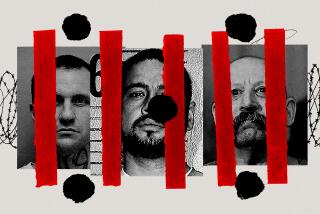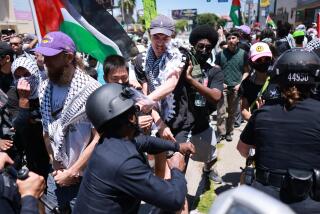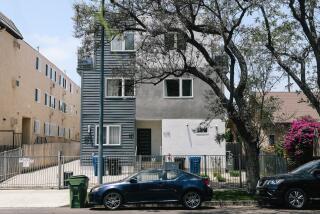FBI Looks for Motive in LAX Attack
A day after a 41-year-old Egyptian immigrant walked into Los Angeles International Airport and killed two people at an El Al ticket counter, authorities said they had uncovered no evidence that the man had any connection to organized terrorist groups, or that he had quarreled with anyone at the airport prior to pulling out his weapons.
FBI officials said they were still looking for clues of terrorist connections to the assailant, a devout Muslim who died in the ensuing shootout with security guards. They also said they were trying to figure out if the gunman, Hesham Mohamed Hadayet, might have been despondent, suicidal, motivated by ethnic hatred--or a combination of all of those factors.
Terrorism, however, “certainly can’t be ruled out,” said FBI spokesman Matt McLaughlin.
Authorities said they had little meaningful evidence so far, and appealed for the public’s help.
Authorities said Hadayet parked his new Mercedes with personalized license plates “GOALIS” in the parking garage directly in front of the El Al Israel Airlines ticket counter shortly before the 11:30 a.m. shooting. Dressed in a dark suit jacket and light shirt, he carried a 6-inch knife in a scabbard on his hip, and had 9-millimeter and .45-caliber handguns. Both guns were registered to him. He also had a loaded magazine for each weapon stuffed in each of his pockets--the 9 millimeter in his right front pocket, the .45 in his left.
Arranging the magazines in this way suggested he intended to fire many rounds, officials said, and that he had experience using firearms.
“It is the most efficient way to reload,” McLaughlin said. “He didn’t get that opportunity.”
Hadayet began firing toward the counter from somewhere in the ticket line, about 20 feet back, McLaughlin said. He said investigators had concluded that witness reports of an argument preceding the shots were unsubstantiated, and they believe the man said nothing before firing.
An unarmed El Al security guard nearby was the first to leap toward him in an effort to tackle him. This guard grabbed the attacker, who was still holding his gun, but could not immediately subdue him, and Hadayet was able to fire more shots.
“He didn’t say a single word,” recalled one bystander, Orna Yarzin of Los Angeles, who said the gunman was firing with a deliberate air, aiming and shooting rather than firing indiscriminately.
As the two wrestled, a second, armed security guard behind the counter moved forward, firing possibly two times as he approached the melee, and ultimately joining the struggle, along with at least one bystander, McLaughlin said. At least two passengers claimed Thursday to have helped subdue the gunman, and several bystanders corroborated the account of one of them, Israeli emigre Arie Golan.
During the fight, the armed guard was stabbed three times by the assailant, including once through the back.
“It was a very dynamic situation,” McLaughlin said. “One security guard was wrestling him while he was shooting. The El Al security guard leapt over the counter, fired one round at some range and fired one or more rounds as he closed, because the man continued to fire. He had the knife with a 6-inch blade in the other hand and was wielding that as well.”
The exact sequence of events remains unclear, however, said McLaughlin, including such details as when bystanders joined the fight and when the shooter’s gun skittered away.
McLaughlin disputed accounts from bystanders that Hadayet had been shot after being disarmed and held on the ground. The Los Angeles Police Department also cited contradictory accounts. McLaughlin said authorities do not know exactly when Hadayet received the fatal shot, or at what range.
He said the gunman may have been shot as the second security guard approached him, and that he had managed to continue struggling for some moments after receiving the mortal wound. Law enforcement officials did not deny witness accounts that Hadayet was shot while held on the ground. But they suggested a different sequence of events.
Several witnesses gave similar accounts to The Times. Among them was Hakim Hafidh, a fitness instructor from Germany, who was checking in at the adjacent LTU International Airways terminal when the shooting began. He said he saw one security guard and Golan wrestle the man to the ground.
“When he fell to the ground, the gun fell to the side,” Hafidh said. “I heard someone scream ‘Don’t touch the gun!’ ”
Next, according to Hafidh, his girlfriend, Petra Dutschek, and two companions, William and Cornelia Bergmann, the second El Al security guard approached the writhing trio and shot the gunman.
“I felt he had lost [the struggle] before they shot him,” Hafidh said.
That account may not conflict significantly with the FBI’s version of events, however. Although Hadayet may have dropped one gun, he had another, and was able to seriously wound the second guard with a knife.
“Our understanding is that he was still struggling, he was still fighting with both the knife and the pistol. He may have been on the floor, but until the moment he died he was still armed and fighting,” said David Douek, spokesman for the Israeli Consulate in Los Angeles.
An autopsy will be performed. Coroner’s spokesman Craig Harvey said Hadayet’s body had not yet been examined--in fact, was still clothed Friday--and therefore authorities could not say how many times he had been shot, or where. Law enforcement authorities would not describe the wounds, although their accounts suggest he may have been shot twice. A photograph taken by a bystander appears to show a wound in the abdomen.
The dead bystanders were Israeli emigre Jacob Aminov, 46, a diamond importer who lived in North Hollywood, and Victoria Hen, a 25-year-old immigrant from Israel working as a ticket agent for a company under contract with El Al.
Authorities praised the two security guards who risked their lives to subdue Hadayet. So too did Andrew Phillips, a Canadian whose mother, Sarah Phillips, 61, was shot in the right ankle. She was one of two people hospitalized for injuries in the attack. The El Al guard was the other.
“I think they handled a terrible situation really well,” Andrew Phillips said. “They stopped this madman, or whatever he was.”
Sarah Phillips was recovering Friday at Centinela Hospital after surgery to repair four tendons damaged by the gunshot. She had been planning to take an El Al flight to Toronto. From her hospital bed, she recalled that when a bolt of pain hit her ankle, she assumed a firecracker had hit her.
“Then people started shouting ‘Get down! Get down!’ and I knew it was a gun, I knew I’d been shot,” she said.
LAPD investigators said they used fingerprints from a weapon used in the attack to link the gunman to state Department of Motor Vehicle records, got a description of his car, then found it in the parking garage in the late afternoon. Authorities said they found Hadayet’s driver’s license in the car but no ticket or luggage.
Authorities plan to search his home computer and bank records, and were examining documents found in his home in both English and Arabic, FBI officials said. They said they had reviewed videotapes from airport security cameras but had found no footage of the attack.
In the hours immediately after the shooting, Israeli authorities said they believed it was an act of terrorism. U.S. officials said it appeared to be an isolated incident unrelated to international terror.
On Friday, both sides softened their stances. U.S. officials said they were not discounting the possibility of terrorism. And Douek, the Israeli consular spokesman, said Israel was not ruling out the possibility that the attack was motivated by something else.
“When it comes down to it, the difference may not be that great,” Douek said. “What we’re saying is that given the circumstances, the background of the attacker, the airline and past history, it looks to us very much like it’s a terrorist attack.... Until that’s ruled out, that’s our top consideration. We’re not saying it definitely was a terrorist attack but that it appears to be.”
Richard Garcia, special agent in charge of the FBI’s Los Angeles criminal branch, said Hadayet arrived in the United States in 1992. “He’s obtained a green card and has the status to stay in the country based on that green card,” he said. “He has no criminal history.”
Ron Rogers, a spokesman for the Immigration and Naturalization Service, described Hadayet as a legal permanent resident who entered the United States in July 1992 on a tourist visa.
That authorized him to remain in the country until January 1993. He then applied for a green card--a legal residency card--and was turned down in February 1996. The INS put him in deportation proceedings. Before he could be deported, however, Hadayet won a reprieve in August 1997 when his wife, Hala, won a green card through a lottery.
Every year, 55,000 immigrant visas are available through the Department of State’s diversity lottery program for people from countries with low rates of immigration to the United States. Winners in this lottery receive a visa authorizing them along with their spouse and any unmarried children under 21 to live and work permanently in the United States.
Hadayet’s wife and two sons are in Cairo visiting relatives.
On Friday morning, Egyptian police arrived at the apartment of Hadayet’s father in downtown Cairo, the building’s security guards said. The guards would not let reporters go up to the apartment in the six-story building in Abbasiya, a middle-class section of the Egyptian capital. Hadayet’s uncle Hassan Mostafa Mahfouz said Hadayet’s wife and sister had been picked up by Egyptian intelligence for questioning. FBI officials also interviewed family members.
A few minutes later, a woman arrived, and shouted at reporters, saying, “I will not speak to these dogs who have no respect for death!” She would not identify herself but neighbors said she was Hadayet’s wife.
Mahfouz said Hadayet did not belong to any political or religious group. “He was an average Muslim who prays regularly just like we all do.”
“I don’t believe what happened,” he added. “I don’t believe the American government’s reports because they are confusing.”
He said Hadayet had worked as an accountant in a bank in Cairo before he went to the United States.
Police in Irvine, where Hadayet and his family lived, said they had had three encounters with him since 1996--once as a robbery victim, once as a crime witness and once when they were called to investigate a domestic dispute.
In the domestic case, Irvine Police Lt. Dave Freedland said, both Hadayet and his wife told officers in May 1996 that each had been the victim of an assault and battery by the other. Prosecutors declined to file charges against either of them, he said, citing a lack of evidence.
Neighbors at the Woodbridge Pines Apartments described Hadayet as a devoutly religious man who had somewhat chilly relations with his non-Muslim neighbors. They said his wife and sons were much friendlier.”I tried to say hi to him when he first moved in and he completely ignored me,” said Pamela Paulson, 51, who lives two apartments away.
“He was stone cold. If he looked at you, he looked right through you.”
More to Read
Sign up for Essential California
The most important California stories and recommendations in your inbox every morning.
You may occasionally receive promotional content from the Los Angeles Times.









